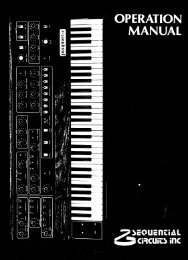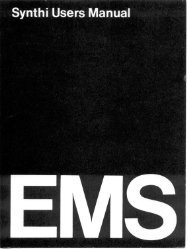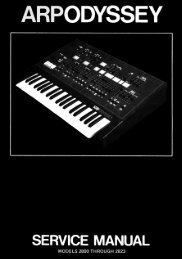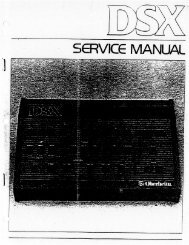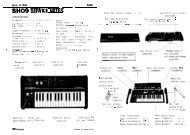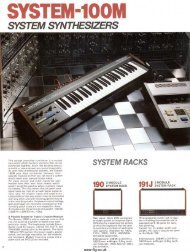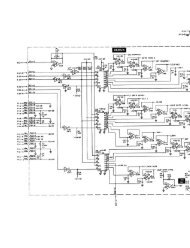ARP2600 - Fundamentals of Music Technology - Cyborgstudio.com
ARP2600 - Fundamentals of Music Technology - Cyborgstudio.com
ARP2600 - Fundamentals of Music Technology - Cyborgstudio.com
You also want an ePaper? Increase the reach of your titles
YUMPU automatically turns print PDFs into web optimized ePapers that Google loves.
SECTION6VCFA BRIEF INTRODUCTION TO SUBTRACTIVE SYNTHESISThe filter is unlike the rest <strong>of</strong> the modules mentioned thus far in that its primary function is not toproduce sound, although it can be used for this purpose. Rather, it is used to change and shape othersounds being made by the other modules <strong>of</strong> the synthesizer.The Voltage Controlled Filter (VCF) is perhaps the single most important part <strong>of</strong> a synthesizer, becauseit determines the overall sound <strong>of</strong> the synthesizer and opens the doors to a new method <strong>of</strong> synthesis:subtractive synthesis. Subtractive synthesis is a method <strong>of</strong> synthesis which starts with one or moreharmonically rich waveforms from which some harmonics are then removed. An oscillator usuallyproduces this harmonically rich waveform, (usually a saw or pulse wave, but sometimes a trianglewave) but it is the filter that performs the task <strong>of</strong> eliminating some harmonics. The filter has severalaudio inputs, so the outputs <strong>of</strong> several oscillators can be connected to just one filter using patch cords.The oscillator’s outputAny VCOOutputNAudioInputVCFAudioOutputTo amplifierand speakersis filtered, and then<strong>com</strong>es out <strong>of</strong> the filter’soutput jack. A blockdiagram <strong>of</strong> a subtractivesynthesis patch canbe seen in Figure 6-1.Notice that every VCOhas an output normalledto the filter.Figure 6-1: A basic subtractive synthesis patchIt is important to understandthat filtering is not like frequency modulation. The two can easily be confused since the FM jackson the VCO’s are aligned perfectly with the audio inputs on the filter. Both also have attenuation slidersabove them, which only adds to the confusion. However, in FM, an in<strong>com</strong>ing control signal modulatesthe frequency <strong>of</strong> the oscillator, but does not pass through the oscillator. On the filter, signals <strong>com</strong>inginto the audio inputs are actually modified by the filter and then passed through to the speakers oranother module as shown by the dotted line in Figure 6-1. Notice also that both modules are outlinedwith green, indicating that there is no modulator in this relationship. Notice also that the signal flowingfrom the VCO to the VCF is an audio signal, not a control signal.BASIC PRINCIPLES OF FILTERINGFiltering, by definition, means to remove certain elements from others. A filter on a synthesizer is adevice which removes some harmonics. As an example, if one fills a glass with water and then placesmarbles into the glass, we have a perfect analogy <strong>of</strong> a harmonically rich waveform. Say the marbles arethe harmonics that one wishes to remove, and the water represents the harmonics one wishes to preserve.When the contents <strong>of</strong> the glass are poured through a handkerchief, the marbles are not permittedthrough. They are filtered, while the water is allowed to pass through, mostly unchanged.042




